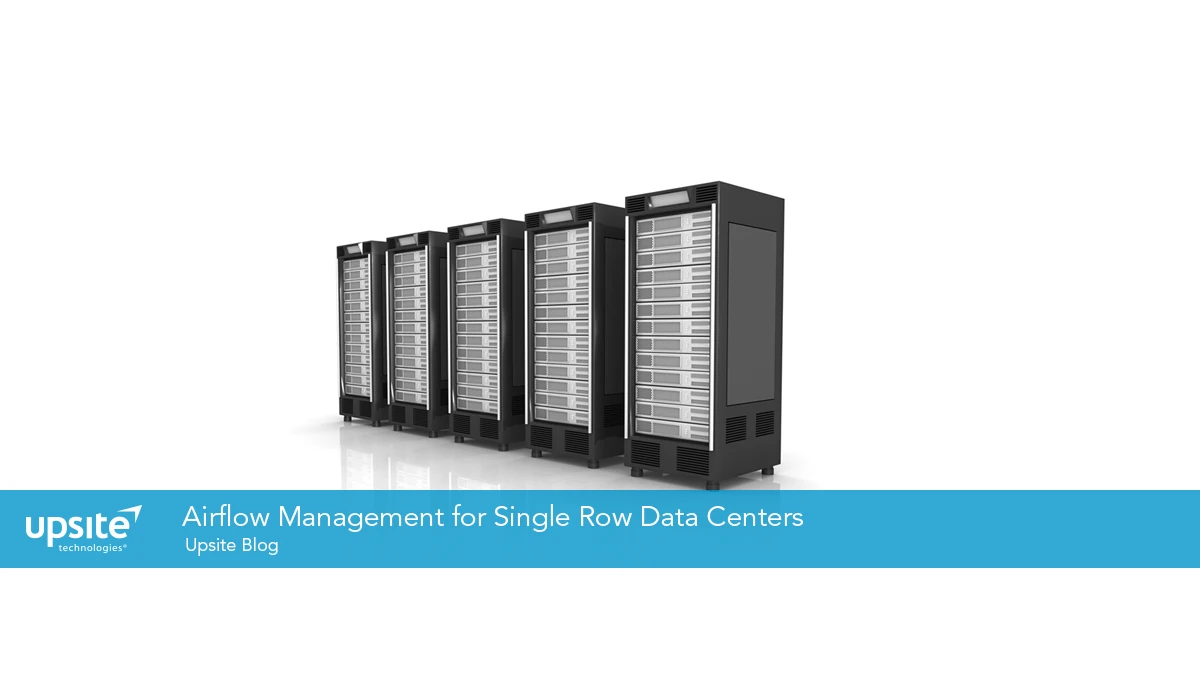Airflow Management for Single Row Data Centers12 min read

Going back to Labor Day week, I have crafted a series of six blogs exploring different barriers to data center air containment and explained how to overcome those obstacles while still producing dramatic increases in energy efficiency, lower operating costs, and opportunities to support higher heat (computing power) densities. In case you missed them, in the first blog, I looked at fire suppression systems, which are frequent problems for containment. The second in the series covered mechanical systems such as single speed air handler fans and DX cooling units, which many in the industry view as inhospitable to reaping containment benefits. The third piece addressed overhead obstacles such as network and power distribution pathways and busses, ductwork, lighting and Unistrut-type structures. The fourth blog discussed a space with a slab floor and no suspended ceiling resulting in no apparent path for either supply separation or return separation. The fifth installment of this series represented a bit of a departure from the focus on room design toe-stubs to a check on how IT decisions can undermine the best airflow management design intent by specifying ICT equipment that does not breathe front-to-back. Finally, the most recent piece addressed problems associated with different size server cabinets or cabinets from various vendors in the same row. Frequently, these situations are why there is no consideration for data center airflow containment. I demonstrated how to overcome those obstacles and, where appropriate, described specific containment variations to address these uncertain environments. I did not specifically cover any possible cost obstacle associated with containment, though there is several years’ worth of blogs, white papers and technical briefs providing plenty of evidence that airflow containment, appropriately executed, will always have a handsome return on investment and quick payback. (www.upsite.com – check blog and resources tabs). So what else might remain?
How can you do hot aisle containment or cold aisle containment in single row data centers data centers or computer rooms? After all, there is no cold-aisle or hot aisle to contain. This kind of question is one of the reasons that I proposed, some time ago in fact, that we tweak our terminology so that HAC and CAC mean hot air containment and cold air containment rather than refer to aisle containment. This proposal is rather straightforward, so a side trip to the archives will not be necessary. For example, it makes a lot more sense to categorize a chimney cabinet as a means of hot air containment than it does to make it a somewhat misfit subgroup of hot aisle containment. Likewise, a hot-aisle containment structure integrating in-row coolers is going to look exactly like cold aisle containment in all other regards, thereby arguing for a functional category rather than a structural category. That said, there are a variety of paths to creating and managing effective air containment in a room with a single row of server cabinets.
The purest form of hot and cold air separation in a room with a single row of server cabinets provides access to all the benefits of containment without the actual physical containment. Think about a row of server cabinets on a raised floor, facing away from the cooling unit(s), with the minimum spacing between the cooling units and the row of cabinets. Spacing such as this is an elegant separation of supply and return air masses. Cold air is then supplied underneath the floor and cabinets and delivered through perforated floor tiles in front of the cabinets. Hot exhaust air is evacuated out the rear of the cabinets directly into the return air intake of the cooling units, located approximately three to five feet away. There is no opportunity for re-circulation of the waste air into the area of cold air use. There would theoretically be an opportunity for some bypass airflow if supply volume far exceeded IT load demand, however, that type of waste is minimized with variable air volume fans as part of the cooling unit specification. Any number of feedback loops could then control fan speed to reduce bypass, such as under-floor pressure, cooling unit ΔT, and temperature readings on top of the server cabinets. You can achieve a variation of this model of hot and cold separation on a slab floor with up-flow cooling units and ductwork to deliver cold air into the area in front of the cabinets.
Incorporating the row of cabinets into a barrier that bisects the room will achieve a more readily recognizable form of physical separation between cold and hot air masses. This kind of containment can lend itself to any supply and return topology. The two that I previously worked with were both on slab floors. In one, a municipal data center in the Pacific Northwest, custom walls extended from the cabinet tops to the ceiling and from the ends of the rows to the adjacent walls. An indirect evaporative cooler, located on the roof that supplied air directly into the cold half of the room, and a return duct on the other side of the barrier drew air into a mixing box in front of the indirect cooling coils. Another example was in a financial institution data center in the northeast where the data center was on the roof in a long room sized for the single row of server cabinets with workspace in front of and behind the cabinets. As before, construction of a custom wall around the cabinets that bisected the room was necessary. Outside air was drawn into the cold side and then waste air was either evacuated out through the wall on the hot side or re-circulated to keep the cold side from being too cold. This latter example also belies some myths about the scale of a single row computer room. In this case, the cabinets housed multiple blade server chassis totaling about 23kW per cabinet, so it is safe to think of it as a data center rather than a computer room. While both these examples employed custom site-built physical air barriers, there is no reason why the same results could not be achieved with walls from a standard containment solution. One advantage of the conventional containment solution is that it minimizes the amount of carpentry activity in a live data center.
Chimney cabinets represent another easy path for delivering air containment for a room with just a single row of server cabinets.
There is no reason to regard a facility with just a single row of server equipment cabinets as a poor fit for containment. Single row build-outs may provide a more accessible path to highly efficient separation at even lower implementation costs, thereby increasing the operating cost benefits derived from requirements for lower air volume, efficiency gains from higher operating temperatures, and access to significantly more hours of free cooling.
Data center airflow containment is not only a documented best practice in all data center standards, some state and municipal building and energy codes mandate the practice. Nevertheless, containment is still not as ubiquitous as the EIA rack. In this series of seven blogs, I have endeavored to address some of the more typical reasons cited for not implementing containment and to explain how those apparent obstacles are not necessarily impediments to enjoying the benefits of data center air containment. If I have omitted some obstacle in containment that you would like to see addressed, just leave a comment to that effect. One caveat: it would not be my intent to solve a particular application problem in a blog; there are Upsite Technologies application engineers and sales engineers who are happy to help with your specific questions. However, if there is a general subject that might be of interest to our readership, let me know.

Ian Seaton
Data Center Consultant
Let's keep in touch!
Airflow Management Awareness Month
Free Informative webinars every Tuesday in June.
0 Comments